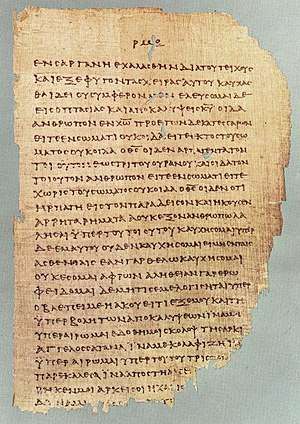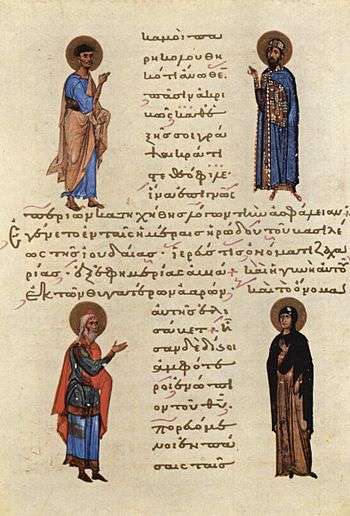Textual criticism of the New Testament
Textual criticism of the New Testament is the analysis of the manuscripts of the New Testament, whose goals include identification of transcription errors, analysis of versions, and attempts to reconstruct the original.

The New Testament has been preserved in more than 5,800 Greek manuscripts, 10,000 Latin manuscripts and 9,300 manuscripts in various other ancient languages including Syriac, Slavic, Ethiopic and Armenian. There are approximately 300,000 textual variants among the manuscripts, most of them being the changes of word order and other comparative trivialities.[1][2]
Text types
The sheer number of witnesses presents unique difficulties, chiefly in that it makes stemmatics in many cases impossible, because many copyists used two or more different manuscripts as sources. Consequently, New Testament textual critics have adopted eclecticism after sorting the witnesses into three major groups, called text types (also styled hyphenated: text-types). The most common division today is as follows:
| Text type | Date | Characteristics | Bible version |
|---|---|---|---|
| The Alexandrian text-type (also called the "Neutral Text" tradition; less frequently, the "Minority Text") | 2nd–4th centuries CE | This family constitutes a group of early and well-regarded texts, including Codex Vaticanus and Codex Sinaiticus. Most of this tradition appear to come from around Alexandria, Egypt and from the Alexandrian Church It contains readings that are often terse, shorter, somewhat rough, less harmonised, and generally more difficult. The family was once thought to be a very carefully edited 3rd century recension but now is believed to be merely the result of a carefully controlled and supervised process of copying and transmission. It underlies most modern translations of the New Testament. | NIV, NAB, NABRE, Douay, JB and NJB (albeit, with some reliance on the Byzantine text-type), TNIV, NASB, RSV, ESV, EBR, NWT, LB, ASV, NC, GNB |
| The Western text-type | 3rd–9th centuries CE | This is also very early and comes from a wide geographical area stretching from North Africa to Italy from Gaul to Syria. It is found in Greek manuscripts and in the Latin translations used by the Western church. It is much less controlled than the Alexandrian family and its witnesses are seen to be more prone to paraphrase and other corruptions. It is sometimes called the Caesarean text-type. Though, some New Testament scholars would argue that the Caesarean constitutes a distinct text-type of its own. | Vetus Latina |
| The Byzantine text-type; also, Koinē text-type (also called Majority Text) | 5th–16th centuries CE | This is a group of around 80% of all manuscripts, the majority of which are comparatively very late in the tradition. It had become dominant at Constantinople from the 5th century on and was used throughout the Church in the Byzantine Empire. It contains the most harmonistic readings, paraphrasing and significant additions, most of which are believed to be secondary readings. It underlies the Textus Receptus used for most Reformation-era translations of the New Testament. | KJV, NKJV, Tyndale, Coverdale, Geneva, Bishops' Bible, OSB, EOB |
Alexandrian text versus Byzantine text

The New Testament portion of the English translation known as the King James Version was based on the Textus Receptus, a Greek text prepared by Erasmus based on a few late medieval Greek manuscripts of the Byzantine text-type (1, 1rK, 2e, 2ap, 4, 7, 817).[3] For some books of the Bible, Erasmus used just single manuscripts, and for small sections made his own translations into Greek from the Vulgate.[4] However, following Westcott and Hort, most modern New Testament textual critics have concluded that the Byzantine text-type was formalised at a later date than the Alexandrian and Western text-types. Among the other types, the Alexandrian text-type is viewed as more pure than the Western and Byzantine text-types, and so one of the central tenets in the current practice of New Testament textual criticism is that one should follow the readings of the Alexandrian texts unless those of the other types are clearly superior. Most modern New Testament translations now use an Eclectic Greek text (UBS5 and NA 28) that is closest to the Alexandrian text-type. The United Bible Societies's Greek New Testament (UBS5) and Nestle-Aland (NA 28) are accepted by most of the academic community as the best attempt at reconstructing the original texts of the Greek NT.[5]
A minority position represented by The Greek New Testament According to the Majority Text edition by Zane C. Hodges and Arthur L. Farstad argues that the Byzantine text-type represents an earlier text-type than the surviving Alexandrian texts. This position is also held by Maurice A. Robinson and William G. Pierpont in their The New Testament in the Original Greek: Byzantine Textform, and the King James Only Movement. The argument states that the far greater number of surviving late Byzantine manuscripts implies an equivalent preponderance of Byzantine texts amongst lost earlier manuscripts. Hence, a critical reconstruction of the predominant text of the Byzantine tradition would have a superior claim to being closest to the autographs.
Another position is that of the Neo-Byzantine School. The Neo-Byzantines (or new Byzantines) of the 16th and 17th centuries first formally compiled the New Testament Received Text under such textual analysts as Erasmus, Stephanus (Robert Estienne), Beza, and Elzevir. The early 21st century saw the rise of the first textual analyst of this school in over three centuries with Gavin McGrath (b. 1960). A religiously conservative Protestant from Australia, his Neo-Byzantine School principles maintain that the representative or majority Byzantine text, such as compiled by Hodges & Farstad (1985) or Robinson & Pierpont (2005), is to be upheld unless there is a "clear and obvious" textual problem with it. When this occurs, he adopts either a minority Byzantine reading, a reading from the ancient Vulgate, or a reading attested to in the writings of an ancient Church Father (in either Greek or Latin) by way of quotation. The Neo-Byzantine School considers that the doctrine of the Divine Preservation of Scripture means that God preserved the Byzantine Greek manuscripts, Latin manuscripts, and Greek and Latin church writers' citations of Scripture over time and through time. These are regarded as "a closed class of sources" i.e., non-Byzantine Greek manuscripts such as the Alexandrian texts, or manuscripts in other languages such as Armenian, Syriac, or Ethiopian, are regarded as "outside the closed class of sources" providentially protected over time, and so not used to compose the New Testament text.[6] Other scholars have criticized the current categorization of manuscripts into text-types and prefer either to subdivide the manuscripts in other ways or to discard the text-type taxonomy.
Textual criticism is also used by those who assert that the New Testament was written in Aramaic (see Aramaic primacy).[7]
Interpolations
In attempting to determine the original text of the New Testament books, some modern textual critics have identified sections as interpolations. In modern translations of the Bible such as the New International Version, the results of textual criticism have led to certain verses, words and phrases being left out or marked as not original. Previously, translations of the New Testament such as the King James Version had mostly been based on Erasmus's redaction of the New Testament in Greek, the Textus Receptus from the 16th century based on later manuscripts.
According to Bart D. Ehrman, "These scribal additions are often found in late medieval manuscripts of the New Testament, but not in the manuscripts of the earlier centuries," he adds. And because the King James Bible is based on later manuscripts, such verses "became part of the Bible tradition in English-speaking lands."[8]
Most modern Bibles have footnotes to indicate passages that have disputed source documents. Bible Commentaries also discuss these, sometimes in great detail.
These possible later additions include the following:[9][10]
- the longer ending of Mark, see Mark 16 (Mark 16:9–20).
- Jesus sweating blood in Luke, Christ's agony at Gethsemane (Luke 22:43–44).
- the story in John of the woman taken in adultery, the Pericope Adulterae (John 7:53–8:11).
- an explicit reference to the Trinity in 1 John, the Comma Johanneum (1 John 5:7–8).
Other disputed NT passages
Opinions are divided on whether Jesus is referred to as "unique [or only-begotten: Gk. monogenes] Son" or "unique [monogenes] God", in John 1:18[10]
1 Corinthians 14:33–35. Gordon Fee[11] regards the instruction for women to be silent in churches as a later, non-Pauline addition to the Letter, more in keeping with the viewpoint of the Pastoral Epistles (see 1 Tim 2.11–12; Titus 2.5) than of the certainly Pauline Epistles. A few manuscripts place these verses after 40[12]
Various groups of highly conservative Christians believe that when Ps.12:6–7 speaks of the preservation of the words of God, that this nullifies the need for textual criticism, lower, and higher. Such people include Gail Riplinger, Peter Ruckman, and others. Many theological organisations, societies, newsletters, and churches also hold to this belief, including "AV Publications", Sword of The LORD Newsletter, The Antioch Bible Society[13] and others. On the other hand, Reformation biblical scholars such as Martin Luther saw the academic analysis of biblical texts and their provenance as entirely in line with orthodox Christian faith.[14][15][16]
References
- Wallace, Daniel. "The Majority Text and the Original Text: Are They Identical?". Retrieved 23 November 2013.
- Westcott and Hort (1896). The New Testament in The Original Greek: Introduction Appendix. Macmillan. p. 2. Retrieved 23 November 2013.
The New Testament in the Original Greek.
- W. W. Combs, Erasmus and the textus receptus, DBSJ 1 (Spring 1996), 45.
- Ehrman 2005, "For the most part, he relied on a mere handful of late medieval manuscripts, which he marked up as if he were copyediting a handwritten copy for the printer. ... Erasmus relied heavily on just one twelfth-century manuscript for the Gospels and another, also of the twelfth century, for the book of Acts and the Epistles. ... For the [last six verses of the] Book of Revelation ... [he] simply took the Latin Vulgate and translated its text back into Greek. ..." (pp 78–79)
- Encountering the Manuscripts By Philip Comfort, 102
- http://www.easy.com.au/~gmbooks/
- Dunnett & Tenney 1985, p. 150
- Ehrman, Bart D.. Misquoting Jesus: The Story Behind Who Changed the Bible and Why. HarperCollins, 2005, p. 265. ISBN 978-0-06-073817-4
- Ehrman 2006, p. 166
- Bruce Metzger "A Textual Commentary on the New Testament", Second Edition, 1994, German Bible Society
- See Gordon Fee, First Epistle to the Corinthians, NICNT (Grand Rapids, MI: Eerdmans, 1987), 699.
- Footnotes on 14:34–35 and 14:36 from The HarperCollins Study Bible: New Revised Standard Version: A New Annotated Edition by the Society of Biblical Literature, San Francisco, 1993, page 2160. Note also that the NRSV encloses 14:33b–36 in parentheses to characterize it as a parenthetical comment that does not fit in smoothly with the surrounding texts.
- Antioch Bible Society
- Kramm, H.H. (2009). The Theology of Martin Luther. Wipf & Stock Publishers. p. 110. ISBN 978-1-60608-765-7. Retrieved 14 May 2017.
- Hendrix, S.H. (2015). Martin Luther: Visionary Reformer. Yale University Press. p. 39. ISBN 978-0-300-16669-9. Retrieved 14 May 2017.
- Note, however, that Luther did not exclusively advocate for disinterested historical reconstruction of the original text. See Evans, C.A. (2011). The World of Jesus and the Early Church: Identity and Interpretation in Early Communities of Faith. Hendrickson Publishers. p. 171. ISBN 978-1-59856-825-7. Retrieved 14 May 2017.